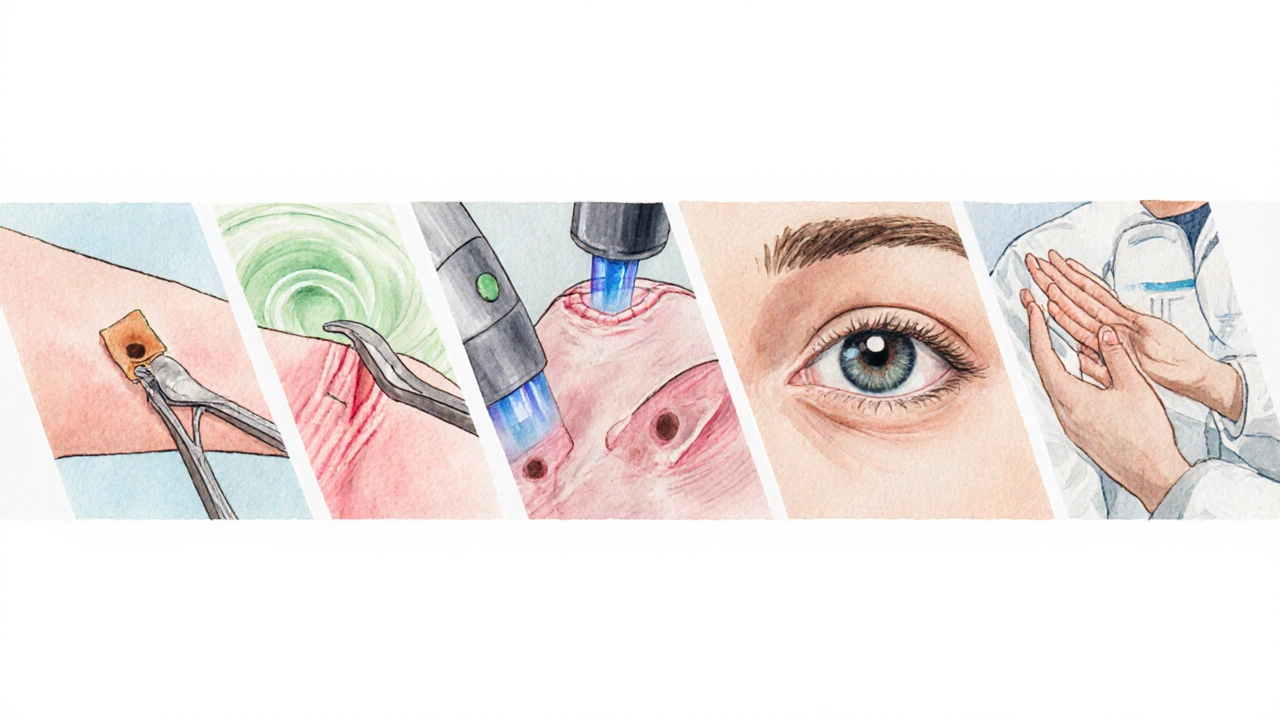
Minor Surgery Cost & Recovery Estimator
Estimate Your Surgery Costs
Select a minor procedure to see typical costs (NZ$) and recovery time
Estimated Details
Cost Range
Recovery Time
When you hear the word “surgery”, you probably picture a long hospital stay and a hefty bill. But not every operation is a major ordeal. If you’re curious about the least serious surgery you can have, especially in the private sector, you’ll find that many procedures are quick, low‑risk, and cost‑effective. Below we break down what makes a surgery “minor”, list the most common low‑risk procedures, and explain how private costs and recovery times compare.
Defining a Minor or Least Serious Surgery
Minor surgery is a procedure that typically requires local anesthesia, involves limited tissue disruption, and carries a low complication rate. In practice, a minor surgery can often be completed in an outpatient setting, meaning you’ll go home the same day. The key factors that separate minor from major surgeries are:
- Level of anesthesia - usually only local or modest sedation.
- Length of the procedure - often under an hour.
- Post‑operative care - minimal need for inpatient monitoring.
- Risk profile - less than 1% chance of serious complications.
Understanding these criteria helps you evaluate whether a particular operation fits the “least serious” category.
Common Low‑Risk Procedures in Private Practice
Below are the most frequently performed minor surgeries in private clinics, along with typical cost ranges (2025 NZ dollars) and expected downtime.
| Procedure | Typical Cost (NZ$) | Recovery Time | Key Risk |
|---|---|---|---|
| Skin tag removal | 150‑300 | Same day, < 24 h soreness | Minor infection |
| Cyst excision | 400‑800 | 1‑2 days limited activity | Scarring |
| Mole removal | 250‑600 | 2‑3 days | Pigment changes |
| Tonsillectomy | 1,200‑2,500 | 7‑10 days | Bleeding, pain |
| Cataract surgery | 2,000‑3,500 | Same day, 1‑2 weeks vision stabilization | Infection, retinal detachment (rare) |
| Carpal tunnel release | 1,500‑2,800 | 1‑2 weeks | Nerve injury (very low) |
| Varicose vein ablation | 2,500‑4,500 | 1‑2 days limited walking | Bruising, skin burns |
Notice how the cost spread is wide, reflecting differences in equipment, specialist expertise, and geographic location. Even within the “least serious” group, procedures like cataract surgery demand higher investment because of specialized lasers and postoperative care.
Why Private Costs Can Vary So Much
Private healthcare pricing isn’t standardized across New Zealand. Several factors drive the final bill:
- Facility fees - hospitals charge for operating room time, sterilization, and recovery rooms.
- Surgeon’s experience - a senior consultant typically commands a higher fee than a junior registrar.
- Technology used - laser‑assisted procedures (e.g., cataract) are priced higher than manual techniques.
- Geographic location - clinics in Auckland or Wellington often have higher overheads than regional centers.
- Insurance coverage - some private health insurers reimburse a portion of the cost, but out‑of‑pocket expenses remain common.
When you book, ask for an itemized quote that separates these components. Transparent pricing lets you compare providers fairly.

Recovery Time: What to Expect After a Minor Surgery
Recovery is a key part of the decision‑making process. Below is a quick guide to downtime for each surgery listed above:
- Skin tag removal - no more than 24 hours before you can resume normal activities.
- Cyst excision - limit heavy lifting for 48 hours; most daily tasks are fine.
- Mole removal - stitches (if used) dissolve in 5‑7 days; avoid sun exposure.
- Tonsillectomy - expect sore throat, avoid solid foods for 3‑4 days; full recovery in 10 days.
- Cataract surgery - vision clears gradually; avoid swimming for a week.
- Carpal tunnel release - light hand use after a day; full strength in 2‑3 weeks.
- Varicose vein ablation - wear compression stockings for a week; can walk immediately.
Even the “least serious” surgeries can interfere with work or school, so factor downtime into your budget.
Choosing the Right Surgeon and Facility
Not all private clinics are created equal. Here’s a short checklist to vet your options:
- Confirm the surgeon’s board certification and years of experience in the specific procedure.
- Ask about the clinic’s infection control protocols. A clean environment reduces post‑op complications.
- Check if the facility offers a post‑operative follow‑up plan. A structured review helps catch issues early.
- Read patient reviews focused on “pain management” and “recovery support”.
- Verify that the quoted price includes all fees - anesthesia, pathology, and any post‑operative dressings.
Taking these steps prevents unpleasant surprises and ensures you get the best value for a low‑risk surgery.

Quick Pre‑Booking Checklist
- Identify the exact procedure you need and its medical justification.
- Gather quotes from at least three private providers.
- Ask about anesthesia options and whether you’ll need any pre‑operative labs.
- Confirm availability of a same‑day discharge plan.
- Check your health insurance for any partial reimbursement.
- Schedule a pre‑op consultation to discuss risks, benefits, and recovery expectations.
With a clear plan, you’ll feel confident that the surgery you choose truly qualifies as the least serious option for your situation.
Frequently Asked Questions
What qualifies a surgery as “minor”?
A minor surgery typically uses local anesthesia, lasts under an hour, requires no overnight stay, and carries a complication rate below 1%.
Are private costs for minor surgeries covered by insurance?
Many private health insurers reimburse a portion of the fee, especially for procedures deemed medically necessary. Always check your policy’s exclusions and claim limits before booking.
How long does it take to recover from a cyst excision?
Most patients return to light activities within 24‑48 hours. Full wound healing typically completes in 7‑10 days, during which you should keep the area clean and avoid heavy lifting.
Is cataract surgery considered a low‑risk procedure?
Yes. Modern phacoemulsification uses a tiny incision and local anesthesia, with success rates above 95% and serious complications occurring in less than 0.5% of cases.
Can I take time off work for a skin tag removal?
Typically no. The procedure takes minutes, and most patients feel normal the same day, making it easy to schedule during a lunch break.